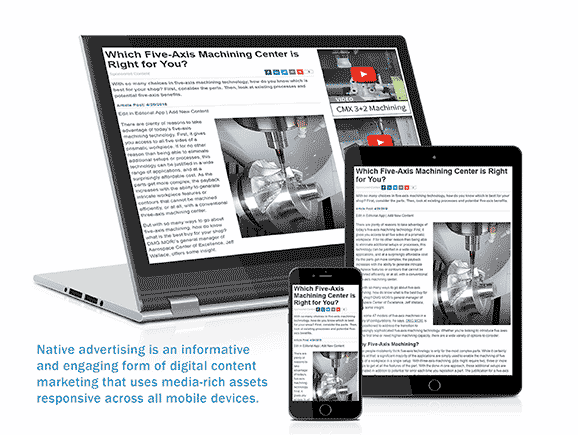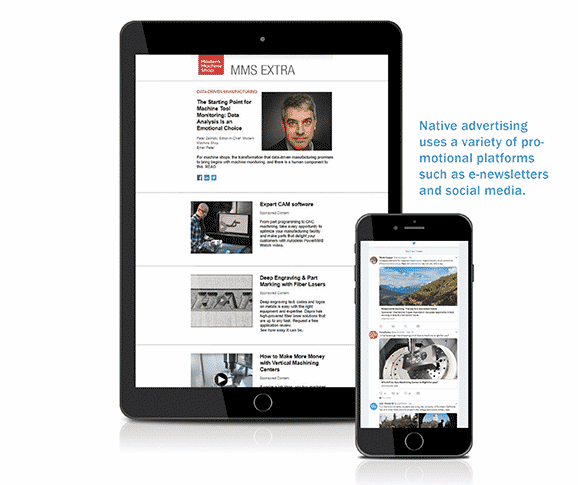Native Advertising: Where Valuable Content and Advertising Meet
Native advertising succeeds where some traditional advertising fails. Here’s how some manufacturing companies are using it to promote their products and services.

By Hannah Coombs, Project Manager, Custom Content
Gardner Business Media, Inc.
More and more manufacturers are looking for ways to integrate digital advertising into their marketing portfolios. Webinars, e-newsletters, banner ads, social media, the list goes on. The types of digital advertising products out there are growing, and as a result it can be a little more challenging trying to figure out which is the right product for your company.
According to the Content Marketing Institute, content marketing is “a strategic marketing approach focused on creating and distributing valuable, relevant, and consistent content to attract and retain a clearly defined audience — and, ultimately, to drive profitable customer action.”
Many small businesses and job shops are probably using content marketing in several ways but just don’t know it. Social media, blog posts, webinars, these are all the kinds of marketing that are centered on highly valuable content. So how do companies go beyond that? How do they integrate all of those platforms?

Native advertising is a form of content marketing that is largely similar to how we think about advertorial content. Native advertising is a paid, third-party format that supports a brand, product or a process but more importantly, the content matches the form, function and quality of the media provider’s own site, on which it appears.
At Gardner Business Media, customers are using native advertising to not only integrate several channels of marketing into one campaign, but they are using it as a way to share long-form, in-depth technical content with our qualified readers. Our native articles are less promotional in nature but more informative. They include rich media assets, images, infographics and video. After the campaign ends, customers receive an in-depth, on-page report that demonstrates exactly how readers are getting to the page and how they engage with the article once they get there.

Benefits of Native Advertising
- High-Quality Content: It’s valuable and informative long-form content that matches the look, feel and quality of the magazine brand’s own content online.
- Media-Rich: It features dynamic use of several media assets such as images, infographics, GIFs, videos and more.
- Data-Driven: Native advertising benefits don’t end once the campaign is launched. The in-depth analytics provided at the end of the campaign through on-page tracking gives a more accurate look of how (and how many) readers are engaging with the content.
- Integrated Distribution: Native advertising uses all forms of distribution at our disposal, such as e-newsletters, social media, print and other related content across the site.
- Brand Trust: Customers get the advantage of the media brand’s trusted and qualified readership so that they can get higher-quality results.
Problem-Driven Solutions
Here are a few ways native advertising succeeds where other marketing forms may not:
Issue #1: Our product is complex and traditional advertising doesn’t give us enough room to convey our message.
Issue #2: We want a quantifiable way to track the success of our campaigns.
Issue #3: We have multiple media assets we want to use, all for the same product.
Issue #4: We want to use multiple marketing channels at once.
Issue #5: We are not yet well-known in the industry and need to grow brand awareness of our company and products.
Native advertising can serve as an alternative method of marketing that can solve any of these challenges. The ultimate requirement—and what ultimately can prevent a company from venturing into native advertising too soon—is good content. Native advertising requires more content than traditional advertising and will only be as successful as it is engaging.
Here are a few examples of how companies have used it at Gardner:
Example 1
Product: Indexable Cutting Tools
Campaign Objective: Challenge common misconceptions about lack of versatility with common indexable cutting tools by showcasing customer’s full line of interchangeable cutting tools for a variety of applications.
Results: Campaign successfully drove readers directly to more information on the customer’s complete portfolio of offerings in the product line.
Example 2
Product: Metal Threaded Inserts for Plastics Industry
Campaign Objective: Introduce a well-known company in one market for threaded inserts into a new one for plastics.
Results: Campaign aligned the customer’s brand with the new products through an informative guide to the different types of inserts and how they’re used, including diagrams and demo videos.
Need more information?
Hannah Coombs
Project Manager, Custom Content
Gardner Business Media, Inc.
6915 Valley Avenue
Cincinnati, OH 45244-3029
513-388-2200 800-950-8020 513-527-8800
Fax: 513-527-8801
About the Author
Hannah Coombs
Hannah Coombs is the Project Manager for Custom Content at Gardner Business Media. She works on all of Gardner’s brands working with customers to produce, edit and promote digital content through custom content marketing campaigns. The Custom Content team is responsible for managing several marketing programs that help customers promote their products and services across digital channels such as native advertising, social media, e-newsletters and custom e-prints, and custom video.
RELATED CONTENT
-
I’m A Puzzle Guy
Looking back, Mark Albert now recognizes that some of his most satisfying moments as an editor revolved around the puzzle-solving aspects of writing an article. Putting an article together was much like the process of solving a puzzle, assembling a model kit, figuring out how to make something work or fixing it if it didn’t.
-
Shifting Landscape of Technology Is a Never-Ending Education
Brent Donaldson, Senior Editor, Modern Machine Shop and Additive Manufacturing Magazine discusses how the shifting landscape of technology that all of Gardner’s writers and editors cover is a never-ending education. If we are truly doing our jobs, we will never feel like we’ve mastered them. As I continue writing and reporting for AM and MMS, it’s easy to imagine how these technologies’ interdependency will continue to grow. It also seems clear that this kind of reporting — the kind that requires editors to experience and share new manufacturing technologies and strategies — is the kind of reporting that only Gardner can produce with any depth. I’m grateful to be part of it.
-
The Art of Letting Live and Letting Go
A sense of control—over our work and personal lives—has been fleeting as the pandemic continues. Becoming a COVID-19 employee and learning to navigate my position remotely has taught me that maybe this isn’t such a bad thing.


